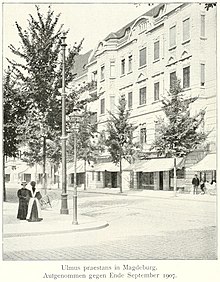Ulmus × hollandica 'Superba'
| Ulmus × hollandica cultivar | |
|---|---|

'Superba', Magdeburg, 1907 (described here by its synonym, Ulmus praestans E. Schoch)
|
|
| Hybrid parentage | U. glabra × U. minor |
| Cultivar | 'Superba' |
| Origin | Europe |
The hybrid elm cultivar Ulmus × hollandica 'Superba' is one of a number of intermediate forms arising from the crossing of the Wych Elm U. glabra with a variety of Field Elm U. minor. Boulger tentatively (1881) and Green more confidently (1964) equated it with a hybrid elm cultivated in the UK by Masters at Canterbury in the early 19th century, known as "Masters' Canterbury Seedling" or simply the Canterbury Elm. Loudon examined a specimen sent by Masters and considered it a hybrid, calling it U. montana glabra major (not to be confused with U. major Smith, U. × hollandica 'Major').
Green (1964) also equated Masters' Canterbury Elm with Osborne's U. montana superba with unusually large leaves, described in 1848 by Morren, though Loudon had made no reference to large leaves.Rehder (1915 & 1949) did not include this identification in his list of synonyms.
An U. praestans E. Schoch, cultivated in Europe in the late 19th century and said by Krüssmann (1984) to have originated in Belgium, was equated by him with U. × hollandica 'Superba'. A 1907 photograph shows an avenue of elms in Magdeburg, Germany, described as U. praestans E. Schoch, a "hybrid between U. scabra [U. glabra] and U. campestris [U. minor]" – i.e. as a form of U. × hollandica. A 'Superba' was reputed by Louis Späth to have been "much esteemed as a street tree in Magdeburg" – presumably the clone in the photograph. This suggests that Späth regarded U. praestans as synonymous with 'Superba'. A 'Superba' had appeared in Späth's catalogues from 1885, from descriptions probably the large-leaved U. montana superba of Morren, not U. praestans. Späth's catalogue of 1911–12 erroneously claimed that U. praestans E. Schoch was synonymous with Morren's U. montana superba.Hartwig, who received specimens of U. praestans from Kiessling of the Magdeburg city nursery in 1908, said (1912) that "Ulmus montana superba, supposedly the same [as U. praestans], looks quite different when young, being wide with large, broad, dull green leaves, whereas U. praestans and U. glabra fastigiata show an elongated medium-sized shiny green leaf and densely pyramidal crown". He concluded that U. praestans was not Ulmus montana superba, but was indistinguishable in leaf or habit from U. glabra fastigiata Kirchner. Späth admitted the error in an article in Möller's Deutsche Gärtner-Zeitung (1912), confirming that U. praestans E. Schoch was an U. × hollandica hybrid, and implying that Morren's tree was a form of U. montana (Wych Elm). He corrected the error in his later catalogues, distinguishing between Morren's Ulmus montana superba and U. praestans E. Schoch (for which he adopted Henry's synonym Ulmus superba Henry), and marketing both cultivars in the interwar period.U. superba Henry was a 'Superba' from Späth himself, planted at Kew in 1900, which Henry had described in 1913. This confirms that Späth had also been marketing U. praestans as 'Superba' in the late 19th century. An undated herbarium specimen from Haarlem showing a hybrid cultivar labelled "U. × hollandica 'Superba' Rehd., received as U. praestans from Späth, Berlin" (see 'External links') matches Henry's description of Späth's tree planted in 1900 at Kew.
...
Wikipedia
